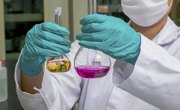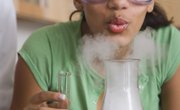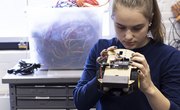Chemistry has the potential to be one of the most interesting high school classes, full of hands-on experiments and impressive chemical reactions. Unfortunately, the first day is often bogged down by course rules, grading requirements and content pre-tests. Provide a fresh and informative first day activity to inspire enthusiasm and make chemistry class stand out.
Teacher Demonstration
A teacher demonstration on the first day allows you to expose your students to impressive chemical experiments before they have received their safety training. Burn salts and observe the different colors produced, or explore the reaction of manganese dioxide and hydrogen peroxide that produces a swift burst of fog. Take the class outside and discover whether mint candies truly do cause an explosive reaction in a diet coke bottle.
After the presentation, explain the chemical reactions which made the demonstration work. Students will leave the classroom full of curiosity and conversing about chemical principles.
Safety Training Activity
Throughout the year, students in a chemistry laboratory course with interact with dangerous materials. Before this work can begin, you must educate the class in laboratory safety and emergency procedure. Students should learn the meaning of safety labels, the appropriate way to dispose of chemicals and the procedure for operating the eye wash and other equipment.
Provide worksheets or a safety video summarizing these procedures. Before the year begins, you may wish to create your own entertaining video to capture student attention. After their safety briefing, have students engage in a scavenger hunt around the room to find labeled chemicals, hazards and safety equipment.
Laboratory Procedure Demonstration
For many students, chemistry class is a first exposure to scientific laboratory work. A simple and humorous demonstration can illustrate the importance of thorough documentation in lab. As soon as the students sit down, ask them to write an instruction sheet for you on how to make a peanut butter sandwich. Collect the papers, and follow the instructions in front of the class.
Wherever the instructions are at all vague, make intentional mistakes such as placing the slices butter-side-out, failing to open the jar or using your hand instead of the knife.
The class will find your antics frustrating and funny. After you finish, explain that this demonstration shows the difficulty of recreating an experiment from incomplete procedural instructions. Discuss how to write in a lab notebook with proper organization and detail.
Chemistry Discussion
While some teachers feel a physical activity is an important component of the first day, others prefer a low-key approach utilizing classroom discussion. After introductions, talk about your background and interests. Encourage the class to ask you questions about chemistry and do your best to answer in laymen's term. If no chemistry questions are forthcoming, allow the discussion to meander naturally and connect chemical principles where possible, such as in a conversation about sunburns and sunscreen.
Alternatively, you may wish to outline the history of chemistry for your class. The early lineage of chemistry, from Aristotle's four elements onward, is a bizarre and approachable story which may engage student interest in the topic.
Related Articles
Writer Bio
Mary MacIntosh has been writing professionally since 2007, contributing articles to "The California Tech" and serving as an editor for the "Biweekly Frink Digest." She is pursuing a Bachelor of Science in computational neuroscience at the California Institute of Technology.










